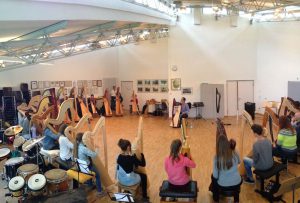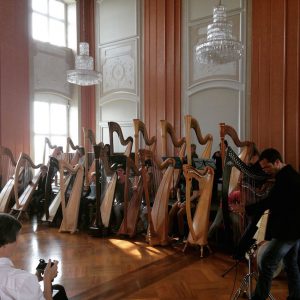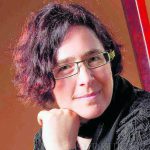Camac Blog
A forest of harps by the shores of Lake Constance
News
August 24, 2015
 At the end of the last season, we went to Tettnang on Lake Constance, Germany, with Nikolaz Cadoret and our partners the Harfengalerie Camac Berlin. The collaboration was part of the Harfengalerie’s Vielsaitig touring project, combining an artistic event, exhibition and service opportunities, in regional centres throughout Germany.
At the end of the last season, we went to Tettnang on Lake Constance, Germany, with Nikolaz Cadoret and our partners the Harfengalerie Camac Berlin. The collaboration was part of the Harfengalerie’s Vielsaitig touring project, combining an artistic event, exhibition and service opportunities, in regional centres throughout Germany.
We received a fantastic welcome from the Musikschule Tettnang. The success of our collaborative touring projects is exactly that: team success, where we all pull together with harpists, students, parents and institutions to create a great experience for everyone.
Simone Häusler, Tettnang’s harp teacher, currently has over sixty students (downsizing from the hundred+ she had before joining the school’s senior management team). Her student harp ensemble, Viva La Harpa, involves seventy harpists on stage at once. This beats even the number of harps Alexis ever surfed in his trademark cover crawl – in any case, against this backdrop of consummate professionalism and organisational wizardry, it could hardly not go well.
It is also difficult to avoid a great event when you are in the hands of Nikolaz Cadoret, whose lever harp skills are among the most virtuoso and dynamic today. He began with a workshop about Breton music. The course participants were removed from their music stands, for they were going to play by ear, and then also removed – temporarily – from their harps! First, they danced the music, then sang it, then played it and then improvised on it. Finally, tradition joined hands with modernity, with the stunning addition of the DHC electric harp.
For the closing concert, we moved to the splendid Rittersaal in Castle Tettnang, where a packed hall waited patiently for us to find the plugs under the antique floorboards. The press were there, the general public was there. There were posters up all over town…all in all, it was not uniquely the harp students and their parents who were involved, but also the town.
 Simone Häusler and her dynamic music school provide a wide range of musical experiences for a large number of children. This, in itself, is essential. Music schools are sometimes somehow pigeonholed as step one on a journey that gets more important later, but nothing could be further from the truth. Good music schools are the foundations of our musical culture. If teaching in the music schools is weak, candidates arrive for conservatoire entrance, hoping to join the profession, and already have no chance. Regardless of what you finally decide to do for a living, there exist countless studies about the importance of music to all children’s personal and social development. Shelley Fairplay, another dynamic teacher with a big class and an energetic student ensemble, told us last year: “I…worked for two years as a primary school teacher before I got too busy as a harpist. I arrived at my school to discover that from nursery age to year six students had never sung anything to live music, they had only ever sung to backing tracks. Because backing tracks are so beat heavy and often played very loud, you can’t truly hear what you’re singing, and the result of this was that many of the children couldn’t pitch at all. They couldn’t hear a line and sing it back, scarcely beat time and they couldn’t make any sort of normal, natural music.” More positively, the Tettnang music school runs courses for mothers and toddlers together, for children as young as two. It also offers lessons in primary schools, lessons for children with special needs, and lessons for physically handicapped children and young people.
Simone Häusler and her dynamic music school provide a wide range of musical experiences for a large number of children. This, in itself, is essential. Music schools are sometimes somehow pigeonholed as step one on a journey that gets more important later, but nothing could be further from the truth. Good music schools are the foundations of our musical culture. If teaching in the music schools is weak, candidates arrive for conservatoire entrance, hoping to join the profession, and already have no chance. Regardless of what you finally decide to do for a living, there exist countless studies about the importance of music to all children’s personal and social development. Shelley Fairplay, another dynamic teacher with a big class and an energetic student ensemble, told us last year: “I…worked for two years as a primary school teacher before I got too busy as a harpist. I arrived at my school to discover that from nursery age to year six students had never sung anything to live music, they had only ever sung to backing tracks. Because backing tracks are so beat heavy and often played very loud, you can’t truly hear what you’re singing, and the result of this was that many of the children couldn’t pitch at all. They couldn’t hear a line and sing it back, scarcely beat time and they couldn’t make any sort of normal, natural music.” More positively, the Tettnang music school runs courses for mothers and toddlers together, for children as young as two. It also offers lessons in primary schools, lessons for children with special needs, and lessons for physically handicapped children and young people.
As our broad local audience in Castle Tettnang showed, the Musikschule’s many special events also position it at the heart of the local community. The music is important to many, not just to those currently taking lessons. When all is said and done, it is is this sort of wider relevance to all ages and stages that keeps music alive.

